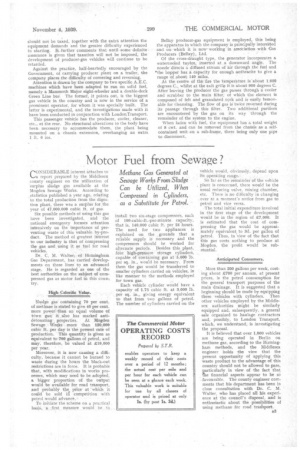Producer-gas Investigations by A.E.C.
Page 28

Page 29

If you've noticed an error in this article please click here to report it so we can fix it.
"Be/lay" Plant Incorporated in Double-decker. Successful Conversion of "Mammoth Major." Development Impeded by Lack of
Government Encouragement FOR some two and a half years, the Associated Equipment Co., Ltd., Southall, has been investigating the possibilities of running road vehicles on producer gas. During that time it claims to have enquired into almost every known type of equipment available for that purpose.
A part of the investigations consisted of making actual trials, on an A.E.C. chassis, of various types of producer and plant, and of testing different fuels. From these, which have extended over many thousands of miles, much data has been collected.
As a result, the company was led to the conclusion that, in normal times, such equipment would have no widespread application. Its view to-day is, in-effect, that even under war conditions producer-gas equipment will make no appreciable headway until the Government gives it recognition and offers practical assistance to its adoption.
So far the Ministry of Transport has confined the helping hand to the raising of no objection to the operation of passenger vehicles drawing trailers carrying the gas plant. No assistance was afforded by a statement recently made that no relaxation of the Regulations governing goods vehicles was necessary, because these could already draw trailers. This is not strictly true, because to use a six or eight-wheeled lorry of maximum length, in conjunction with a trailer is illegal.
E2 Nor has help been forthcoming in the matter of extending the weight limits to cover the extra weight involved by producer plant. Finally, no grounds exist for assuming that solid fuel, if it comes into wider use, will not be taxed. In view of these matters, the Associated Equipment Co., Ltd., does not intend, at least for the present, to manufacture new chassis designed to run on producer gas; it is giving close consideration, however, to the question of converting A.E.C. vehicles now in service for operation on this fuel.
• Corroborating the opinion that has frequently been voiced by this paper, the company has satisfied itself that for producer gas, engines of at least 30 per cent, greater piston displacement are needed to give equivalent performances to modern petrol and oil engines.
It puts this forward as one of the reasons why solid fuel should not be taxed, together with the extra attention the equipment demands and the greater difficulty experienced in starting. It .further comments that until some definite assurance is given that taxation will not be imposed; the development of producer-gas vehicles will continue to be retarded.
Against the practice, half-heartedly encouraged by the Government, of carrying producer plant on a trailer, the company places the difficulty of cornering and reversing.
Attention is drawn by the company to two specific A.E.C. machines which have been adapted to ran on solid fuel, namely a Mammoth Major eight-wheeler and a double-deck Green Line bus:. The former, it points out, is the biggest gas vehicle in the country and is now in the service of a prominent operator, for whom it was specially built. The latter is experimental, and the investigations made with it have been conducted in conjunction with London Transport.
This passenger vehicle has the producer, cooler, cleaner, etc., at the rear. No structural alterations to the body have been necessary to accommodate them, the plant being mounted on a chassis extension, overhanging an extra 1 ft. 6 ins.
Bellay producer-gas equipment is employed, this being the apparatus in which the company is principally intereSted and on which it is nowworking in association with -Gas Producers (Bellay), Ltd.
Of the cross-draught type, the generator incorporates a watercooled tuyere, inserted at a downward angle. The nozzle directs a diffused stream of air through the fuel and the hopper has a capacity for enough anthracite to give a range of about 140 miles.
At the centre of tl* fire the temperature is about 1;650 degrees C., whilst at the exit grille it is about 900 degrees C. After leaving the producer the gas passes through a cooler and scrubber to the main filter, of which the element is composed of felt and granulated Cork and is easily Removable for cleansing. The flow of gas is' twice reversed during its passage through this filter. Two additional purifiers are encountered by the gas on its way through the remainder of the system to the engine.
When laden with fuel, the equipment has a total weight of 8 cwt. and can be removed from the chaSsis as a selfcontained unit on a sub-frame, there being only one pipe to disconnect.




























































